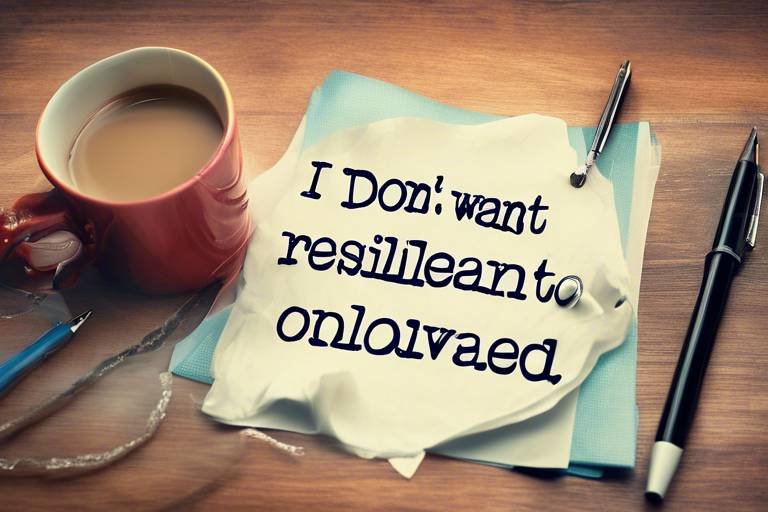The Art of Building Resilience in Children
This article explores the essential strategies and practices for fostering resilience in children, enabling them to navigate challenges and thrive in an ever-changing world.
Resilience is not just a buzzword; it's a vital life skill that allows children to bounce back from setbacks and face life's challenges head-on. Imagine resilience as a rubber band—it stretches under pressure but returns to its original shape when the stress is removed. This ability is crucial as it shapes a child's emotional and psychological development. When children are resilient, they are more likely to cope with stress, overcome obstacles, and emerge stronger from difficult situations. The importance of resilience cannot be overstated; it lays the foundation for a healthy, fulfilling life. A resilient child is not only better equipped to handle adversity but also possesses the confidence to take on new challenges, fostering a sense of independence and self-worth.
Several factors contribute to a child's resilience, and understanding these can help us nurture it effectively. Genetics, environment, and social support are key players in this complex interplay. For instance, a child born into a supportive family with a nurturing environment is likely to develop stronger resilience than one who faces neglect or abuse. It's like planting a seed in fertile soil versus rocky ground; the former has a better chance of thriving. Furthermore, social support from friends, family, and community can bolster resilience by providing emotional backing and resources during tough times. It's essential to recognize how these elements interact, as they can either enhance or hinder a child's ability to cope with life's challenges.
Effective parenting is a cornerstone of nurturing resilience in children. Just as a gardener tends to their plants, parents can cultivate emotional strength and adaptability in their kids through various styles and strategies. Authoritative parenting, characterized by warmth and structure, has been shown to promote resilience. Parents who set clear boundaries while allowing their children to express themselves create an environment where kids feel safe to explore and take risks. This balance is crucial; it teaches children that while challenges are a part of life, they are also manageable. Encouraging open communication is another vital aspect—when children feel heard and understood, they are more likely to develop the confidence to face adversity.
Fostering independence is vital for resilience. Allowing children to make choices and solve problems on their own is like giving them a toolkit for life. When kids are faced with decisions, whether it's picking out their clothes or resolving a conflict with a friend, they learn to trust their judgment. This process enhances their confidence and equips them with essential coping skills. It's important to step back sometimes and let children experience the consequences of their choices, both good and bad. This way, they learn valuable lessons about responsibility and resilience. Just like a bird learning to fly, children need the chance to flap their wings and soar, even if they occasionally stumble.
Children are keen observers, and they learn a great deal by watching the adults in their lives. This makes it crucial for parents and caregivers to model resilient behaviors. When children see their parents handle stress with grace and a positive attitude, they are more likely to adopt similar approaches. For example, if a parent faces a setback at work but chooses to view it as an opportunity for growth, the child learns to reframe challenges positively. It's like passing down a family recipe; the ingredients may vary, but the outcome is a delicious dish that nourishes the soul. By demonstrating how to cope with difficulties, adults can instill resilience in their children, preparing them for the inevitable ups and downs of life.
A supportive environment is essential for resilience. Creating safe spaces where children feel valued, understood, and empowered to express themselves is like building a fortress against the storms of life. This can be achieved by encouraging open dialogue, validating their feelings, and fostering a sense of belonging. When children know they have a solid support system, they are more likely to take risks and face challenges head-on. Additionally, community involvement, whether through sports, clubs, or volunteering, can provide children with a broader network of support. Just as a tree grows stronger with deep roots, children flourish in environments where they feel secure and loved.
Coping strategies equip children with tools to manage stress and adversity. Teaching techniques such as mindfulness, problem-solving, and emotional regulation is crucial for building resilience. Mindfulness practices, like deep breathing or meditation, help children stay grounded during stressful moments. Problem-solving skills enable them to break down challenges into manageable steps, making it easier to navigate difficulties. Emotional regulation teaches children how to identify and manage their feelings, allowing them to respond to situations thoughtfully rather than react impulsively. These skills are like a toolbox; the more tools they have, the better prepared they are to handle whatever life throws their way.
Positive self-talk can significantly impact a child's resilience. Teaching children to replace negative thoughts with constructive affirmations is essential for fostering a healthy mindset. For instance, when a child thinks, "I can't do this," encouraging them to reframe it as "I can try my best" promotes a growth mindset. This shift in perspective empowers children to approach challenges with confidence and optimism. It's like changing the lens through which they view the world; suddenly, obstacles become opportunities for growth. By nurturing positive self-talk, parents can help their children develop a resilient inner voice that supports them through tough times.
Strong social connections are vital for resilience. Encouraging friendships and community involvement provides essential support during challenging times. When children have a network of friends, they feel less isolated and more capable of facing difficulties. Activities like team sports, clubs, or group projects foster camaraderie and teach valuable social skills. It's important for parents to facilitate these connections, as they serve as a safety net during life's ups and downs. Just like a spider's web, the more connections a child has, the stronger their support system becomes, allowing them to navigate challenges with greater ease.
- What is resilience? Resilience is the ability to bounce back from adversity and cope with life's challenges.
- How can I help my child build resilience? Encourage independence, model resilient behavior, and create a supportive environment.
- Why is positive self-talk important? Positive self-talk helps children develop a growth mindset, enabling them to face challenges with confidence.
- What role do social connections play in resilience? Strong social connections provide emotional support and a sense of belonging, which are crucial during tough times.

Understanding Resilience
Resilience is more than just a buzzword; it’s a crucial life skill that enables individuals, especially children, to bounce back from challenges and emerge stronger. Think of resilience as a rubber band—it stretches but doesn’t break. When children face difficulties, their ability to adapt and recover can significantly affect their emotional and psychological growth. But what exactly defines resilience? It's the capacity to recover quickly from setbacks and adapt well to change, trauma, or adversity.
Imagine a child facing a tough situation, like moving to a new school or dealing with a friendship fallout. Resilient children view these challenges as opportunities for growth rather than insurmountable obstacles. This mindset is essential because it shapes their approach to life's ups and downs. In a world that is constantly evolving, fostering resilience in children is not just beneficial; it’s essential for their long-term success.
Why is resilience so important? Well, it lays the foundation for emotional well-being and academic success. Resilient children are more likely to tackle challenges head-on, maintain a positive outlook, and develop healthy relationships. They are equipped with the tools to manage stress and navigate the complexities of life, which can lead to better decision-making and greater overall happiness.
To truly grasp the concept of resilience, we must also consider its components. These include:
- Emotional Regulation: The ability to control one's emotions and reactions.
- Problem-Solving Skills: The knack for finding solutions to challenges.
- Social Support: Having a network of friends and family to lean on during tough times.
- Self-Efficacy: Believing in one’s ability to succeed and overcome obstacles.
Each of these components plays a vital role in how children respond to adversity. For instance, emotional regulation helps them manage feelings of frustration or sadness, while strong problem-solving skills enable them to devise plans when faced with challenges. Social support, on the other hand, provides the encouragement and reassurance they need to keep pushing forward.
In conclusion, understanding resilience is about recognizing its multifaceted nature and appreciating its impact on a child's development. By fostering resilience, we equip children with the skills they need to thrive in an unpredictable world. As parents, educators, and caregivers, it’s our responsibility to cultivate these attributes, ensuring that the next generation is prepared to face whatever life throws their way.

Factors Influencing Resilience
When we think about resilience, it’s essential to recognize that it's not a one-size-fits-all trait. Instead, resilience is shaped by a variety of factors that intertwine in complex ways. Understanding these factors can help us foster resilience in children more effectively. First off, let’s talk about genetics. Some children may have a natural predisposition to be more resilient, while others might face more significant challenges. However, genetics is just one piece of the puzzle. The environment in which a child grows up plays a pivotal role in shaping their ability to bounce back from adversity.
Consider the influence of family dynamics. A nurturing home filled with love and support can act as a protective buffer against stress. In contrast, a chaotic or neglectful environment can hinder a child's development of resilience. This is where the concept of a support system comes into play. Children who have strong connections with family, friends, and mentors are often better equipped to handle life’s challenges. These connections provide emotional support and practical help during tough times.
Moreover, the community surrounding a child is equally important. A positive community can offer resources, encouragement, and a sense of belonging, which are crucial for building resilience. For instance, children who participate in community activities or sports often develop teamwork skills and friendships that enhance their coping mechanisms. Here’s a quick look at some of the key factors influencing resilience:
| Factor | Description |
|---|---|
| Genetics | Natural predisposition to resilience; some children may be more resilient than others. |
| Family Dynamics | A nurturing environment fosters emotional strength, while chaos can hinder it. |
| Social Support | Strong connections with family and friends provide essential emotional backing. |
| Community | A supportive community enhances a child's sense of belonging and resource access. |
In addition to these factors, individual traits also play a significant role. For example, a child's temperament can influence how they respond to stress. Some children are naturally more adaptable and optimistic, while others may struggle with change. This is where the role of parenting becomes crucial, as effective parenting can help children develop the skills they need to navigate life's ups and downs.
Ultimately, resilience is a dynamic interplay of many elements—genetics, environment, social connections, and individual traits all come together to shape a child's ability to cope with challenges. By understanding these factors, we can create strategies that not only support children in their journey but also empower them to thrive in an ever-changing world.

The Role of Parenting
When it comes to building resilience in children, the role of parenting is nothing short of pivotal. Think of parenting as the sturdy foundation upon which a child's emotional and psychological resilience is built. Just like a house needs a solid base to withstand storms, children require strong parental support to navigate life's challenges. But what does effective parenting look like in this context? It involves a blend of love, guidance, and the freedom to explore.
One of the most effective strategies for nurturing resilience is adopting a supportive parenting style. This means being present and available for your child while allowing them the space to make their own decisions. For instance, instead of always stepping in to solve problems for them, encourage your child to think critically and come up with solutions on their own. This not only boosts their confidence but also enhances their problem-solving skills, which are crucial for resilience.
Moreover, it's essential to recognize that children are always watching and learning from their parents. Modeling resilient behavior is therefore incredibly important. When faced with setbacks, how do you react? Do you express frustration, or do you demonstrate a calm and constructive approach to overcoming obstacles? Children absorb these lessons like sponges, and your reactions can significantly influence their own coping mechanisms. For example, if a child sees a parent calmly addressing a stressful situation, they are more likely to adopt a similar attitude when they encounter difficulties.
Creating a nurturing environment also plays a crucial role in fostering resilience. This environment should be a safe space where children feel valued and understood. When children know that they can express their feelings without judgment, they are more likely to develop emotional intelligence and the ability to cope with adversity. Think of it as planting seeds in a garden; with the right nutrients and care, those seeds will grow into strong, resilient plants.
In summary, the role of parenting in building resilience is multifaceted. It involves being a supportive guide, modeling appropriate behaviors, and creating a safe and nurturing environment. By implementing these strategies, parents can equip their children with the tools they need to face life's challenges head-on. The journey of resilience is not just about bouncing back; it's about thriving in the face of adversity, and it all starts at home.
- What is resilience in children? Resilience is the ability of a child to recover from setbacks, adapt to change, and keep going in the face of adversity.
- How can I help my child become more resilient? You can help by providing a supportive environment, encouraging independence, and modeling resilient behaviors.
- Is it okay to let my child fail? Yes, allowing children to experience failure is critical for learning and developing resilience. It teaches them how to cope and recover.
- What are some signs of resilience in children? Signs include a positive attitude, the ability to manage stress, and a willingness to seek help when needed.

Encouraging Independence
When it comes to fostering resilience in children, is like planting a seed that grows into a sturdy tree. Just as a tree needs sunlight and water to thrive, children require opportunities to make decisions and solve problems on their own. By allowing them to navigate challenges independently, we help them build confidence and coping skills that will serve them throughout their lives. Imagine a child standing at a crossroads, unsure of which path to take. If we always guide them, they may never learn to trust their instincts or develop their judgment. Instead, by letting them explore their options, we empower them to become capable decision-makers.
Independence doesn’t mean throwing children into the deep end without a life jacket. It’s about gradually increasing their responsibilities and encouraging them to take ownership of their choices. For instance, you might start with small tasks, like allowing your child to choose their outfit for the day or decide what to have for lunch. These seemingly trivial decisions can be the first steps toward more significant challenges. As they gain confidence, you can introduce more complex situations, like planning a family outing or managing their homework schedule.
Moreover, it’s essential to create a safe space where children feel comfortable making mistakes. Just like a toddler learning to walk, they will stumble and fall. However, each fall is an opportunity for them to learn and grow stronger. Encourage them to view mistakes as stepping stones rather than setbacks. You might say, “It’s okay to mess up! What can we learn from this?” This approach not only fosters resilience but also nurtures a growth mindset, which is crucial for long-term success.
Here are some practical strategies to encourage independence:
- Offer Choices: Present your child with options, whether it's selecting a book to read or choosing between two activities. This empowers them to make decisions.
- Encourage Problem-Solving: When faced with a challenge, ask guiding questions instead of providing solutions. For example, “What do you think we should do next?”
- Set Goals Together: Help your child set achievable goals and create a plan to reach them. Celebrate their successes, no matter how small.
In conclusion, encouraging independence in children is a vital ingredient in the recipe for resilience. By allowing them to make choices, learn from their mistakes, and take ownership of their actions, we equip them with the tools they need to thrive in an unpredictable world. Remember, every step they take toward independence is a step toward becoming a confident, resilient individual.
Q: How can I start encouraging independence in my child?
A: Begin with small choices in daily activities, such as selecting clothes or snacks. Gradually introduce more significant decisions as they become comfortable.
Q: What if my child struggles with making decisions?
A: It's normal for children to feel overwhelmed. Offer support by asking guiding questions and helping them weigh the pros and cons of their options.
Q: How do I handle mistakes my child makes while trying to be independent?
A: Emphasize that mistakes are part of the learning process. Encourage your child to reflect on what they can learn from the experience instead of focusing on the error itself.

Modeling Resilient Behavior
When it comes to fostering resilience in children, one of the most powerful tools we have is our own behavior. Children are like sponges, soaking up everything they see and hear. This means that as parents, caregivers, and role models, we have an incredible opportunity to model resilient behavior in our daily lives. But what does that really mean? It’s about demonstrating how to handle challenges, setbacks, and stressors with grace and determination. Imagine a tree bending in the wind; it may sway and bend, but it doesn’t break. Similarly, when we show our children how to navigate life’s storms, we equip them with the skills they need to stand tall.
One of the first steps in modeling resilience is to embrace challenges ourselves. When we face difficulties, we can openly discuss our feelings and the strategies we use to cope. For example, if you encounter a problem at work, instead of just venting your frustration, talk about how you plan to tackle it. This not only normalizes the struggle but also teaches children that it’s okay to face obstacles head-on. They learn that setbacks are a part of life and that perseverance is key.
Another important aspect is to practice emotional regulation. Children observe how we manage our emotions, especially during tough times. If we can remain calm and collected, even when things go awry, it sends a powerful message. For instance, if you’re stuck in traffic and running late, instead of getting upset, you might say, “Well, this is frustrating, but I can use this time to listen to my favorite podcast.” Showing that we can adapt and find positives in negative situations helps children develop their own coping mechanisms.
Moreover, sharing stories of our own failures and how we bounced back can be incredibly impactful. It’s not just about showing the shiny wins; it’s about being real and relatable. When we talk about a time we didn’t get a job we wanted or faced a personal setback, and how we overcame it, we teach our children that resilience isn’t about never failing; it’s about rising after we fall. This authenticity fosters a sense of trust and understanding, allowing children to feel comfortable expressing their own challenges.
Lastly, it’s crucial to encourage a growth mindset in our children. This concept, popularized by psychologist Carol Dweck, emphasizes that abilities and intelligence can be developed through dedication and hard work. We can model this by praising effort rather than innate talent. For example, instead of saying, “You’re so smart,” we can say, “I’m proud of how hard you worked on that project.” This reinforces the idea that perseverance leads to success, which is a cornerstone of resilience.
In essence, by modeling resilient behavior, we not only teach our children how to cope with life’s challenges but also create a nurturing environment where they feel supported and understood. When they see us navigating difficulties with resilience, they are more likely to adopt those same behaviors. So let’s be the trees that bend but don’t break, showing our children that resilience is not just a trait; it’s a way of life.
- What is resilience? Resilience is the ability to bounce back from adversity and adapt to challenges, which is crucial for emotional and psychological well-being.
- How can I help my child become more resilient? You can help by modeling resilient behavior, teaching coping strategies, and creating a supportive environment.
- Why is modeling behavior important? Children learn by observing adults. When you model resilience, you provide them with a blueprint for handling their own challenges.
- What are some effective coping strategies for children? Techniques such as mindfulness, positive self-talk, and problem-solving can equip children with essential coping skills.

Building a Supportive Environment
Creating a supportive environment is like laying down a strong foundation for a house; without it, everything else can crumble. Children thrive when they feel safe, valued, and understood. Imagine a garden: without sunlight and water, even the strongest seeds will struggle to grow. Similarly, a nurturing environment is essential for children to develop resilience. It’s not just about physical safety; it’s about emotional security too. When children know they are in a place where they can express themselves freely, they are more likely to take risks, learn from their mistakes, and bounce back from failures.
One of the most crucial aspects of a supportive environment is open communication. Parents and caregivers should encourage children to share their thoughts and feelings without fear of judgment. This fosters trust and strengthens the bond between adults and children. For instance, when a child faces a setback, instead of merely offering solutions, adults can ask, “How do you feel about what happened?” This question not only validates the child’s feelings but also opens the door for a deeper conversation about coping strategies.
Moreover, it's essential to create a routine that provides stability. Children benefit from knowing what to expect throughout their day. A predictable schedule can help them feel secure, allowing them to explore their surroundings and tackle challenges with confidence. For instance, having designated times for homework, play, and family meals can help children understand the rhythm of their day. Here’s a simple example of a daily routine:
| Time | Activity |
|---|---|
| 7:00 AM | Wake up and breakfast |
| 8:00 AM | School |
| 3:00 PM | Homework |
| 5:00 PM | Outdoor play |
| 7:00 PM | Family dinner |
| 8:00 PM | Reading time |
Another key element is recognizing and celebrating individual achievements. When children accomplish something, no matter how small, acknowledging their efforts can significantly boost their self-esteem. This can be as simple as a high-five, a sticker chart, or a family celebration. These moments reinforce the idea that hard work and perseverance are rewarded, further encouraging resilience.
Lastly, it’s vital to model empathy and understanding. Children learn a lot by observing the adults around them. When parents show compassion and understanding, children are more likely to mirror these behaviors. For example, if a child sees their parent helping a neighbor or listening to a friend in need, they learn the value of being supportive. This not only builds their emotional intelligence but also creates a ripple effect, fostering a community of resilience.
- What is the best way to support my child emotionally?
Open communication is key. Encourage your child to express their feelings and validate their emotions. - How can I create a routine that helps my child?
Establish a consistent daily schedule that includes time for homework, play, and family activities. - Why is modeling behavior important for children?
Children learn by example. When they see adults demonstrating resilience and empathy, they are more likely to adopt those traits. - How can I celebrate my child's achievements?
Recognize their efforts with praise, rewards, or special family activities to reinforce their accomplishments.

Teaching Coping Strategies
Coping strategies are essential tools that equip children to manage stress and navigate the ups and downs of life. Just like a toolbox filled with various instruments, a child’s ability to cope effectively depends on having a diverse set of strategies at their disposal. Imagine facing a storm without an umbrella; similarly, children need protective measures to shield themselves from emotional downpours. By teaching them specific coping techniques, we prepare them to handle life's challenges with grace and resilience.
One effective method is **mindfulness**, which encourages children to stay present and aware of their thoughts and feelings without judgment. It’s like teaching them to be the calm eye of the storm, where they can observe their emotions and reactions rather than being swept away by them. Simple practices such as deep breathing exercises or guided imagery can help children develop mindfulness. For instance, taking a few deep breaths when they feel overwhelmed can create a moment of clarity, allowing them to respond rather than react impulsively.
Another vital strategy is **problem-solving**. When children encounter obstacles, guiding them through a structured approach to find solutions can be incredibly empowering. This might involve asking questions like, “What’s the problem?” and “What are some possible solutions?” By engaging in this dialogue, children learn that challenges are not insurmountable and that they possess the capability to overcome them. It’s like giving them a map to navigate through unfamiliar terrain, helping them to find their way even when the path seems unclear.
Moreover, teaching **emotional regulation** is crucial. Children often experience a whirlwind of emotions, and helping them understand how to manage these feelings can prevent them from feeling overwhelmed. Techniques such as identifying emotions, expressing them appropriately, and finding healthy outlets, like drawing or physical activity, can provide children with the skills they need to handle their feelings. For example, when a child feels angry, instead of lashing out, they could be taught to express that anger through art or to talk about it with someone they trust.
To further reinforce these strategies, parents and caregivers can create a supportive environment where children feel safe to express their feelings and try out their coping techniques. This nurturing atmosphere acts as a foundation where children can practice their skills without fear of judgment. After all, resilience is not just about bouncing back; it’s about having the confidence to face challenges head-on. As they practice these strategies, they will gradually build a resilient mindset that prepares them for future hurdles.
In summary, teaching coping strategies is like equipping children with a survival kit for emotional and psychological challenges. By incorporating mindfulness, problem-solving, and emotional regulation into their daily lives, we empower them to face difficulties with confidence and resilience. The journey to resilience may not always be easy, but with the right tools and support, children can learn to navigate their emotional landscapes with strength and grace.
- What are coping strategies? Coping strategies are techniques that help individuals manage stress and navigate challenges effectively.
- How can I teach my child mindfulness? You can teach mindfulness through simple practices like deep breathing, meditation, or guided imagery exercises.
- Why is emotional regulation important? Emotional regulation helps children manage their feelings, preventing them from becoming overwhelmed and allowing them to respond to situations more effectively.
- What role do parents play in teaching coping strategies? Parents play a crucial role by modeling coping strategies, providing a supportive environment, and encouraging open discussions about emotions.

Encouraging Positive Self-Talk
When it comes to building resilience in children, one of the most powerful tools at our disposal is positive self-talk. Imagine this: every day, we have a little voice inside our heads that narrates our experiences. For children, this inner dialogue can either lift them up or drag them down. Encouraging positive self-talk helps kids replace negative thoughts with constructive affirmations, ultimately shaping their self-esteem and emotional well-being.
So, how do we cultivate this invaluable skill in our children? First off, it's essential to create an environment where self-expression is encouraged. When children feel safe to share their thoughts and feelings, they are more likely to articulate negative feelings and then learn to counter them with positivity. For instance, if a child says, "I'm terrible at math," we can guide them to reframe that thought to, "I may struggle with math right now, but I can improve with practice." This simple shift in language can make a world of difference.
Another effective strategy is to introduce affirmations. These are positive statements that can help children challenge and control negative thoughts. You might say, "Let's create a list of things you like about yourself." This not only boosts their self-esteem but also provides them with a resource they can refer to whenever they feel down. Consider creating a colorful poster of affirmations that they can hang in their room. Here’s a quick example of what that might look like:
| Affirmation | Meaning |
|---|---|
| I am capable of achieving my goals. | This reinforces their ability to succeed. |
| I am loved and valued. | This helps them feel secure in their relationships. |
| I can learn from my mistakes. | This encourages a growth mindset. |
Moreover, it’s crucial to model this behavior as parents and caregivers. Children are like sponges, absorbing everything around them. If they see you practicing positive self-talk, they are more likely to adopt the same habits. For example, if you make a mistake, instead of saying, "I'm so stupid," try saying, "I made a mistake, but I can learn from it." This not only demonstrates resilience but also provides a practical example for them to follow.
Lastly, don't forget to celebrate their victories, no matter how small. When your child accomplishes something, even if it's just finishing a challenging puzzle or getting through a tough day at school, acknowledge it! Say something like, "You worked really hard on that, and I'm so proud of you!" This reinforces their ability to succeed and encourages them to keep talking positively about themselves.
In summary, encouraging positive self-talk isn't just about changing words; it's about transforming a child's mindset. It empowers them to face challenges head-on and fosters a sense of resilience that will serve them throughout their lives. The next time you hear your child engaging in negative self-talk, take a moment to guide them towards a more positive narrative. After all, the words we say to ourselves can shape our reality, and teaching children to speak kindly to themselves is one of the greatest gifts we can give them.
- What is positive self-talk?
Positive self-talk is the practice of using affirming and encouraging statements to improve one's mindset and emotional well-being. - How can I help my child with negative self-talk?
Encourage them to reframe negative thoughts into positive ones and model this behavior yourself. - Are affirmations effective?
Yes! Affirmations can help reinforce a positive self-image and promote resilience. - What role do parents play in fostering positive self-talk?
Parents can model positive self-talk, create a safe space for expression, and celebrate their child's achievements.

Promoting Social Connections
In a world that often feels disconnected, among children is more crucial than ever. Just like a tree needs strong roots to withstand a storm, children need a solid network of friends and family to thrive in the face of life's challenges. Social connections not only provide emotional support but also teach children vital life skills such as empathy, teamwork, and conflict resolution. Have you ever noticed how a child’s mood can brighten instantly when they’re surrounded by friends? That’s the power of social connections!
Building these connections starts at home. Parents and caregivers can create opportunities for children to interact with peers in a variety of settings. For instance, encouraging playdates, joining clubs, or participating in community sports can help children form friendships. But it’s not just about quantity; it's also about quality. Meaningful relationships foster a sense of belonging and security, which are essential for developing resilience. So, how can we help children cultivate these important relationships?
One effective way is by modeling social behavior. Children learn by observing the adults around them. When they see their parents engaging in friendly conversations, showing kindness, and resolving conflicts peacefully, they are more likely to mimic those behaviors. It's like planting seeds in a garden; the more you nurture them, the more they grow. Additionally, parents can facilitate social interactions by organizing group activities that encourage cooperation and teamwork. This could be as simple as hosting a game night or organizing a neighborhood clean-up.
Furthermore, it's important to teach children about the value of diversity in friendships. Encouraging them to befriend peers from different backgrounds can broaden their perspectives and enhance their social skills. For example, if a child plays with friends from various cultures, they learn to appreciate differences and develop a more inclusive mindset. This not only enriches their social experiences but also prepares them for a diverse world.
Moreover, fostering a sense of community is vital. Children who feel connected to their community are more likely to seek support when they face difficulties. Schools and community organizations play a significant role in this aspect. Programs that promote teamwork, such as group projects or community service, can help children build lasting relationships. It’s like creating a safety net; the more connections they have, the more secure they feel.
In conclusion, promoting social connections is an essential component of building resilience in children. By nurturing these relationships through modeling behavior, encouraging diversity, and fostering community involvement, we equip children with the tools they need to navigate life's ups and downs. After all, in the grand tapestry of life, it's the connections we make that truly enrich our experiences.
- Why are social connections important for children? Social connections provide emotional support, enhance social skills, and help children develop resilience.
- How can I encourage my child to make friends? Organize playdates, encourage participation in group activities, and model positive social behavior.
- What role does diversity play in children's friendships? Friendships with diverse peers broaden perspectives and help children develop empathy and inclusivity.
- How can schools promote social connections? Schools can implement group projects, team sports, and community service activities to foster relationships among students.
Frequently Asked Questions
- What is resilience in children?
Resilience in children is the ability to bounce back from challenges and adversity. It's like a rubber band; the more you stretch it, the more it can return to its original shape. This quality helps children navigate life's ups and downs, fostering emotional and psychological growth.
- Why is resilience important for children?
Resilience is crucial because it equips children with the skills to handle stress, overcome obstacles, and maintain a positive outlook. Think of it as building a mental toolbox; the more tools they have, the better prepared they are to face life's challenges.
- How can parents help build resilience in their children?
Parents can foster resilience by using effective parenting strategies, such as encouraging independence, modeling resilient behaviors, and creating a supportive home environment. It's about giving children the freedom to make choices and learn from their experiences, much like teaching them to ride a bike without training wheels.
- What role does a supportive environment play in resilience?
A supportive environment is essential for resilience as it provides children with safe spaces to express themselves and feel valued. When children know they have a strong support system, they are more likely to take risks and tackle challenges head-on, much like a plant growing stronger with the right care.
- What coping strategies can help children manage stress?
Effective coping strategies include mindfulness, problem-solving, and emotional regulation techniques. Teaching children to practice deep breathing or to break problems into smaller, manageable parts can help them handle stress better, similar to how a marathon runner trains to tackle each mile one step at a time.
- How can positive self-talk influence resilience?
Positive self-talk can significantly boost a child's resilience by helping them replace negative thoughts with constructive affirmations. Just like a coach encouraging an athlete, positive self-talk can empower children to believe in themselves and tackle challenges with confidence.
- Why are social connections important for resilience?
Strong social connections provide essential support during tough times. Friends and community involvement can act as safety nets, helping children feel less isolated and more capable of facing challenges. It's like having a team to cheer you on during a big game!



















